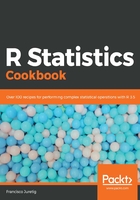
上QQ阅读APP看书,第一时间看更新
There's more...
The TraMineR package allows us to plot histograms for the sequences. The interpretation is analogous to a regular histogram, with the obvious difference that the histogram is indexed by time:
seqdplot(mvad.seq, with.legend = T,group=group__, border = NA, title = "State distribution plot")
The following screenshot shows the TraMineR histograms:

For every case, L1 is the most frequent tier, maybe except for females F-26-45. In this case, L3 and L2 are quite important. It seems that for both groups between 18 and 25, there are no clients moving to groups L2/L3 until Week 10, and even when they do, they don't seem to stay much time in either one compared to both groups in the 26-45 range. We can also confirm that females F-18-25 are generally more likely to close their accounts.